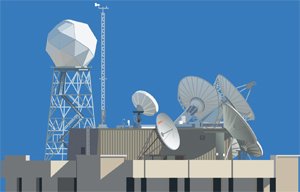 |
Director's NoteFred Best |
In light of all the news about the Government sequester, shutdown, and looming debt ceiling issue, it seems a bit of clarification as well as a few reassuring words are in order. First the clarification: SSEC employees work for SSEC, not the Federal Government. So if you receive direction to “stop work” from Federal employees or Contractors, please pass this information on to SSEC management. If we receive a project related stop work order, we may need to reassign you to a different project for a while, or we may decide keep you working on that project for a while on our nickel.
Now for the reassuring words - all of our anticipated funding from the CIMSS Cooperative Agreement for the last fiscal year, is in house. Additionally, through the Hurricane Sandy Disaster Relief Funding, SSEC has received funding for three projects; expansion of the S4 supercomputer ($1M, Liam Gumley, PI); addition of two new antenna sites to SSEC’s Direct Broadcast network ($1.2M, Liam Gumley, PI); and a study to provide quality control and impact assessments of automated aircraft observations in global data assimilation models ($200K, Dave Santek, PI). Here is a brief overview of these projects:
S4 is the Supercomputer for Satellite Simulations and Data Assimilation Studies (S4) High Performance Computing (HPC) system that is funded by NOAA and used by both NOAA and UW researchers to run data assimilation experiments with the goal of improving the operational weather models used to generate weather forecasts for the United States. When the original S4 system was installed in 2011, it was the most powerful supercomputer on the UW-Madison campus with 3,072 CPU cores, 8.2 TB RAM, and 520 TB of storage, all connected by a 40 gigabit-per-second network. This system was designed, installed, and is maintained by the UW SSEC Technical Computing Group. SSEC is guaranteed 10% of the use of this system for its own needs, in addition, many of the users granted access via NESDIS/STAR (for the other 90%) are CIMSS and other scientists that are located here at SSEC.
The upgrade provided by the Sandy funding will double the original S4 capability, allowing global satellite data assimilation experiments to be run with higher resolution. Scott Nolin points out that SSEC’s 10% usage of this system is at least 50% more processing power than the next largest computer cluster currently at the center.
The funding for the Direct Broadcast project will add two new antenna sites to the network of polar satellite direct broadcast reception sites across North America and the Northern Pacific to provide real-time advanced infrared and microwave sounder data to NOAA NCEP for assimilation in numerical weather prediction (NWP) models. The new sites will be located in Miami, Florida and Puerto Rico will add to existing sites operated by SSEC at Madison and Honolulu. Additionally, there are partner sites at Monterey FL, Suitland MD, Fairbanks AL, Corvallis OR, and Guam. At present, NOAA/NCEP use of advanced infrared (CrIS, IASI, AIRS) and microwave (ATMS, AMSU) sounder data over North America in NWP data assimilation is limited because of the latency of the products in relation to the cutoff times for assimilation runs. The Direct Broadcast network delivers infrared and microwave sounder data to NCEP with the lowest latency possible, via the reception and processing of data received via direct broadcast.
The intent of the aircraft observation study is to evaluate and improve the use of aircraft measurements of temperature, wind, and humidity information in NCEP global forecast models, especially (GDAS/GFS). Over the past two decades the Aircraft Meteorological Data Relay (AMDAR) program has grown from producing several thousands observations of wind and air temperature over a limited geographic region, to one that now produces nearly 300,000 reports per day worldwide. CIMSS has had a lot of experience in the past assessing the impact of AMDAR data on NWP models. The new study will provide assessments to the NCEP GDAS/GFS model.
Finally, on an administrative note, for Unclassified members of SSEC, if you haven’t yet dealt with your annual review form, please try to get it to your supervisor as soon as possible.

